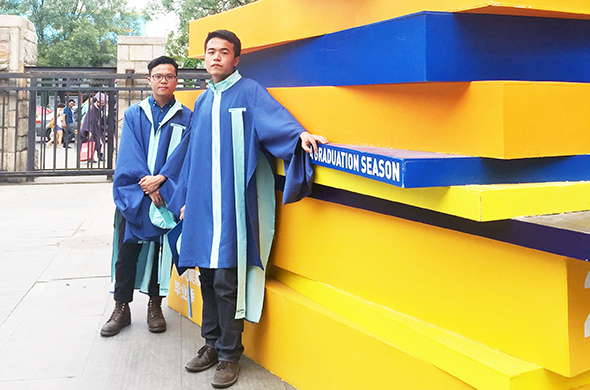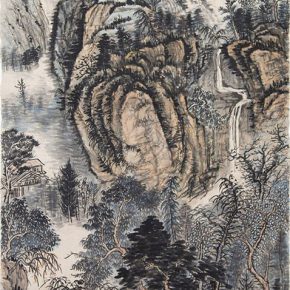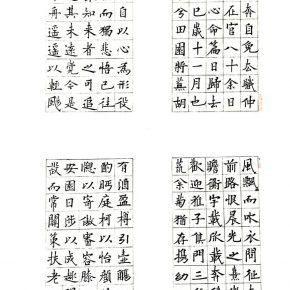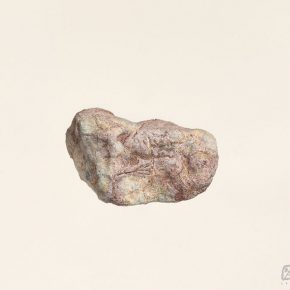Chen Jiahao is an undergraduate graduate from CAFA who majored in Chinese calligraphy; Cao Kuo is an undergraduate graduate from the 4th studio of the Department of Oil Painting, CAFA. Although they have different specialties, creative forms and style orientation, they have a similar character, and became friends who are on the same wavelength during their study in CAFA, which in fact digests their professional distance. During the graduation season, these two have chatted sincerely on their respective professions and individual graduation creations, and the “chat” between friends often became more lively, vivid and real, revealing CAFA’s undergraduate graduates’ understanding of their own specialties.
(The following text is edited on the basis of the content of the conversation between Chen Jiahao and Cao Kuo)
Chen Jiahao: Contemporary Studies on Inscriptions on Tripods with Two Handles
In ancient times, the literati considered Chinese calligraphy as a daily cultural accomplishment, and it is also the most traditional form of artistic expression, revealing a strong historical sense of current keyboard styles. Born in the 1990s, Chen Jiahao’s practice of calligraphy focuses on the early period of the formation of calligraphic art in the Shang and Zhou Dynasties, and his undergraduate graduation creation is themed on the inscriptions on tripods with two handles, combined with his own writings that researched calligraphy.
The calligraphic specialty of CAFA launched a one-month course in the “Foundation of Ancient Characters” for the sophomores, to study the representative bronze inscriptions of the period of Shang and Zhou dynasties, studying the evolutionary process of characters, copying and practicing them, the course stimulated his interest and drove him to finish his graduation creation “Collection of Inscriptions on Tripods with Two Handles in the Shang and Zhou Dynasties”. The work is a collection of the research achievements on inscriptions by the previous scholars, for example, the text is originated from “All Previous Dynasties Clock Tripods with Two Handles Sacrificial Vessels Inscription Calligraphy Copybook” by Xue Shanggong in the Southern Song Dynasty, the copybook collects the inscriptions of a total of 90 tripods with two handles, together with inscriptions, explanations, textual criticisms, unearthed places, and other content which Chen based his work on using the form of regular script in small characters to rearrange it and strove to explore a new change in the art of composition. The whole set of work uses the traditional “wrapped-ridge binding” from the Song imperial court to manually bind the volumes and both the albums and cover are handmade, in order to restore the aesthetic charm of ancient calligraphy as far as possible.
In addition to “Inscriptions on Tripods with Two Handles”, he finished the creation of a set of seal cuttings at the same time, which are also on show at the graduation exhibition, Chen hopes to present the professional skills which he has learned over the last 4 years in different ways. Calligraphy is a special category of art, gradually forming a creative pattern into an integrated book, painting and seal cutting in the developing process of ancient literati painting, so Prof. Wang Yong from the specialty of calligraphy of CAFA organized and founded the teaching mode that focuses on the integration of book, painting and seal cutting, which is also a tradition of the specialty of calligraphy of CAFA. For the seal cutting of his graduation work, Chen created these on the basis of the seal cuttings of the Qin and Han dynasties and attempted to create a new form in the content including seal stamps and side inscriptions.
Cao Kuo: Drawing a Pair of Extremely Fine Gloves for a Reflection on the Demise and Rebirth
In the Department of Oil Painting, Cao Kuo is a student interested in realistic oil painting, but he accidentally joined in the 4th studio, which focuses on expression, and all the students draw on the theme of expressionism, but he individually submerged himself in contrast into the realistic painting, on the other hand, CAFA’s studio system applies a relatively relaxed teaching environment, teachers support students who choose their own style.
For creation, Cao Kuo is interested in the theme of corruption and extinction. At the beginning he used watercolor to draw some stones, when he went to Maiji Mountains to sketch, the residence was full of disordered rocks, which were changed to interesting pieces, after the collision, fragmentation, erosion by water and even artificial cutting, Cao thought them interesting and brought them back to draw. He then found gloves that would perfectly convey what he wanted to express, so he drew this set of gloves.
He started from the aspects of “demise” and “rebirth”, Cao the reflected on “gloves”, which are produced and used by people, and finally abandoned, in the process, they are worn, spotted, torn, destroyed, while the superficial texture looks like wrinkles, as if skin gradually aged and finally dies. While life is reduced, it is also given a new meaning, hands are extremely complex and flexible, and also reflects the true feelings of people, therefore gloves also have the factor of “human”, gloves are produced by machinery, being cold, but after being worn for a long period, they more and more look like hands, and even replace hands in working, superficially emerging the actions and textures which basically coincide with hands, and I am enthralled by this relationship.
In the summer of 2016, they graduate from different specialties of CAFA, Cao Kuo is fortunate in winning a postgraduate recommendation, so he will continue with postgraduate study and continue to use the ultra-realistic system to create, but he will choose “people” as the subject in the future, which will be conducive to the formation of his own creative trail. Chen Jiahao will continue to take the entrance examination for postgraduate study while being seriously engaged in what he is interested in, the sincere quality will make him succeed.
Edited by Zhang Wenzhi, translated by Chen Peihua and edited by Sue/CAFA ART INFO
Photo by Chen Jiahao and Cao Kuo



























































